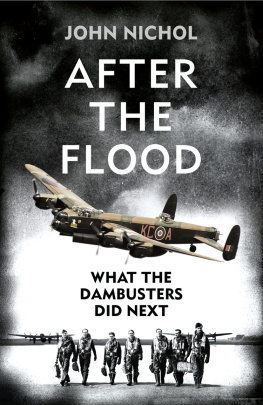Bretwalda Battles
The Dambusters
World War 2
by Leonard James
Published by Bretwalda Books
Website : Facebook : Twitter : Blog
This ebook is licensed for your personal enjoyment only. This ebook may not be re-sold or given away to other people. If you would like to share this book with another person, please purchase an additional copy for each person. If you're reading this book and did not purchase it, or it was not purchased for your use only, then please purchase your own copy. Thank you for respecting the hard work of this author.
First Published 2016
Copyright Bretwalda Books 2016
Leonard James asserts his moral rights to be regarded as the author of this work.
Contents
- The Trouble with Inventer Chaps
- The Dams
- The Bouncing Bomb
- The Squadron
- The Raid
- Aftermath
The Trouble with Inventer Chaps
Back in 1916 Bomber Harris had been a young major leading a fighter squadron in the tough and dangerous business of protecting England against the Zeppelin airships. He was one day sent a device produced by an inventor who declared it to be a foolproof method of destroying Zepplins. The device consisted of an explosive charge on the end of a wire which was dangled down beneath the fighter. The fighter then flew over the Zeppelin so that the charge hit the airship, exploding on impact and setting fire to the aerial monster.
Harris tried it out on a routine flight and found it a positive menace. The wire and charge seriously hampered the fighter and almost caused him to crash. Next day the inventor came down to the airfield to see how his invention was doing. Harris explained the problems to the man, who at first refused to accept that his brainchild was useless.
Well, said Harris, why not forget the dangling wire and just drop the charge on to the Zeppelin?
The inventor brightened up. Yes, that might work, he said.
But the charge will need to be streamlined so that it will fall accurately, suggested Harris.
Absolutely, agreed the inventor.
And you will need some way to release it from the aircraft.
The inventor beamed. Youre right, he said. Ill get back to work and see what I can come up with.
Just a moment, snarled Harris. He pointed to his aircraft. What the Hell do you think those things are?
The things to which Harris pointed were light incendiary bombs designed for dropping on Zepplins. From that moment on Harris was proverbially hostile to what he called inventor chaps armed with half-baked plans.
By early 1943, Harris had also developed an aversion to what he called panacea targets, by which he meant single targets the destruction of which promised to cause massive damage to the German war effort. Several such targets had been proposed, but they had all proved to be either impossible to hit effectively or, if hit, not to be quite so essential to the Germans as had been thought.
So when an inventor chap approached Harris with a half-baked plan to knock out a panacea target, Harris was inclined to turn him down flat. It was only because Mutt Summers, chief test pilot with Vickers and a personal friend, put in a word of support that Harris agreed to a meeting. So it was that Harris met Barnes Wallis, already famous as the designer of the Wellington, among other aircraft, and of numerous devices related to aircraft.
The targets that Wallis wanted to destroy were the three dams in the hills east of the Ruhr Valley. These dams - the Mohne, Sorpe and Eder - between them provided vast amounts of hydro-electricity for use by the industries of the Ruhr. Just as important they held back 400 million tons of water from the winter rains for use during the summer months, and it took eight tons of water to produce each ton of steel. Without water the German steel industries would grind to a halt. Moreover, if the dams were breached the resulting flood waters were swamp towns and cities, flood out coal mines, destroy crops in the fields and inflict untold other forms of damage on miles of German countryside.
An Inventer Chap wanting to destroy a Panacea Target. Nothing could be more calculated to annoy Bomber Harris.
The Dams
The chain of events that led up to the famous Dambusters Raid began the day before war was declared. Aircraft designer Barnes Wallis, who had designed the Wellington bomber for Vickers, decided to search for a way in which bombers could cripple Germanys industrial might and so shorten the war. He quickly came to the conclusion that this could best be achieved by destroying either the sources of power or the means of transport. He turned to power first.
The Romanian oilfields were too distant for bombers to reach from Britain and coal mines were too deep underground to be affected by bombs. That left dams. Germany was fortunate in having mountainous regions close to her industrial centres. These mountains had high rainfall and deep valleys, which made them ideal for building dams. These dams provided hydro-electric power, but they also stored the vast quantities of water needed by 1940s heavy industry. And they were often used as reservoirs for the canal system as well. Destroy a dam, reasoned Wallis, and you could badly hit power, industry and transport in one go.
There were three dams that stood out as being key to Germanys industry, all of them in the range of hills between the Rhine and Ruhr rivers. The Moehne Dam held 134 million tons of water. The Eder held 212 million tons of water and also fed water into the Mittelland Canal, Germanys busiest industrial waterway. The Sorpe held around 180 million tons of water and fed drinking water to the surrounding cities. Together the three provided getting on for half the electric power of the vast Ruhr industrial metropolis.
That the destruction of the dams would be a huge blow to Germany, nobody could doubt. The question was how to go about destroying them.
Dams are, by their very nature, enormously strong structures. They are also long and narrow targets to try to hit with bombs from the air. Wallis knew that even the largest bomb then in existence would barely scratch the surface of one of the massive concrete structures, even if a bombaimer could hit it.
The Mohne Dam today.
The lines of Walliss thoughts thus far had been followed by others. The RAF had considered the dams as a target, but then discarded the idea as being impossible to carry out from the air. The Germans concluded much the same, so they put only light defences at the dams.
But Wallis was not deterred. As an engineer he knew that the concrete dams were strong, but brittle. If he could find a way to shake the dams with enough force they would shatter to pieces. After months of work he realised that the key was to generate shockwaves. This could best be done by putting a concentrated charge pressed up against the wall of the dam about 50 feet below the surface of the water. This position would mean that the shockwaves from the explosion would be reflected back by the weight of the water into the concrete of the dam. In turn this would shake the dam with great force, shattering the concrete.























